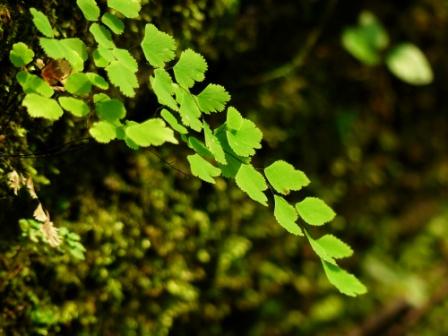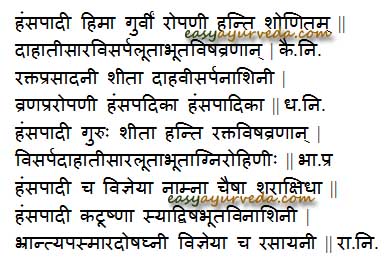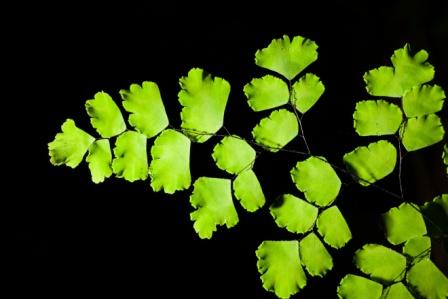Hamsapadi – Adiantum lunulatum is an Ayurvedic herb used for the treatment of diarrhea, poisonous effect due to insect bite, wound, herpes, cough, dysuria and hoarseness of voice.
Latin name- Adiantum lunulatum Burm.
Family- Polypodiaceae (Hamsaraja kula)
Table of Contents
Vernacular names
Names in different languages:
Hindi name : Hamsapadi, Samalapatti, Hansaraj, Hanspadi, Hansapadi,
English name : Walking fern, Maiden hair, Maidenhair Fern, Walking Maidenhair Fern
Bengali name : Goyaliya lata, Kali jaant, Goyaliya lata, Kali saaha, Kali
Gujarati name : Hamsara, Hamsaraj kali dandalino
Kannada name : Naviladi
Marathi name : Hamsapadi, Lal laajaalu
Tamil name : Seruppadai
Telugu name : Hamsapadamu
Kannada : Naviladi
Pharasi : Parsya ushan
Porebunder : Hansaraj, Kalohansaraj
Tagalog : Caicai, Gayomanmanoc, Lamotlamotan
Philippines : Culantrillo

Morphology
Morphology of Adiantum lunulatum:
This herb is a fern growing in an area near a water source and moist place. The fern grows to a height of 1-1.5 feet. The stem part grows and is found beneath the ground. The stem of the leaf is smooth, reddish black colored. The leaflet is curvy, oval shaped 0.5-1 inch long.
Properties, part used, dosage
Hamsapadi medicinal properties:
Rasa (Taste) – Kashaya (Astringent)
Guna (Qualities) – Guru (Heavy)
Vipaka – Madhura (Undergoes sweet taste after digestion)
Veerya (Potency) – Sheeta (Cold)
Karma (Actions) – Kaphapitta shamaka (reduces vitiated kapha and pitta dosha)
Hamsaraja – Part used-
Whole plant
Dosage-
Juice- 10 to 20 ml
Powder- 1 to 3 g
Chemical composition
Chemical composition of Adiantum lunulatum:
The chemical constituents are chlorophyll degradation products and higher carotenoids. The active principles in this are 16-Hentriacontanone,Hentriacontane,Adiantone, Beta sitostiroles, Triterpenes-fernene, adiantone, Isoadiantone, Sugar, Protein, Fat, Phenol, quercetin-3-o-glucoside, filic-3-ene,a new triterpine alcohol, 29-norhopan-22-ol, flavanoids including rutin and isoquercitin, tannin.
Uses
Medicinal uses of of Hamsapadi:
- The paste of Hamsapadi is applied over the area affected with herpes and wound as part of treatment.
- The paste of Adiantum lunulatum is applied over the area bitten with scorpion and spider bite. The fresh juice is given in a dose of 20-25 ml to nullify the effect of poison.
- Powder of Hamsapadi is given in a dose of 3-5g with buttermilk to treat diarrhea.
- The powder is given with honey in a dose of 3-5 g to treat cough, hoarseness of voice and rhinitis.
- To treat difficulty in urination, the cold infusion of Adiantum lunulatum is given in a dose of 40-50 ml.
- The whole plant is applied externally to burns.
- Juice of the fresh plant is applied to Abscesses and Wounds for quick healing. Fresh juice of the fronds is used for the treatment of dysentery, ulcer and burning sensation.
- The leaves are Anti-inflammatory.
- The whole plant is applied externally to Burns
- The plant can be used as Anti Poisonous.
- The fronds, made into plaster, are applied to chronic Gouty and other swellings, also to chronic tumours.
- Fronds burnt with oil, used as an application for itch.
- The root is Anti-pyretic, Carminative.
- In hoarseness of voice caused by vata, oil cooked with the root of Hamsapadi should be instilled in nostrils.
Sanskrit verse

Indications
Traditional uses of Maidenhair Fern:
Ropani – heals wounds
Raktaprasadini – coolant and hence supports blood tissue.
Rasayana – anti aging, causes cell and tissue rejuvenation
Indicated in –
Asra – blood disorders such as abscess, skin disorders, bleeding disorders such as menorrhagia, nasal bleeding etc.
Daha – burning sensation, as in gastritis, neuropathy, burning sensation in eyes etc
Atisara – diarrhea, dysentery
Visarpa – herpes
Lutha – insect bite
Bhuta – psychiatric disorders, anti microbial
Visha – Toxic conditions, poisoning
Vrana – Ulcers, wounds
Apasmara – Epilepsy

Adverse effect
It is a coolant and not ideal in high Kapha conditions.
No adverse effect is known after the use of Hamsapadi
Interaction with medicines, supplements
Can this be used while taking Homeopathic medicine?
Yes. This product does not react with homeopathic medicine.
Can this medicine be continued while taking supplements like multivitamin tablets, Omega 3 fatty acids etc?
Yes. Generally, this product goes well with most dietary supplements. However, if you are taking more than one product per day, please consult your doctor for an opinion.
With western
medicines
Seek your
doctor’s advice if you are taking this product along with other western
(allopathic / modern) medicines. Some Ayurvedic herbs can interact with modern
medicine.
If both Ayurvedic and allopathic medicines are advised together, then it is
best to take Allopathic medicine first, wait for 30 minutes and then take the
Ayurvedic medicine.
Ayurvedic medicines
Ayurvedic medicines containing Hamsapadi:
Kalakuta rasa: It is an ayurvedic medicine in tablet form used in the treatment of chronic bronchitis, cough, urinary tract disorders, diabetes, fever etc.
Manasamitra vataka: It is a tablet used in the treatment of psychiatric conditions, to improve intelligence, speech problems, to treat epilepsy, seizures etc.
Karimbirumbadi kashaya: It is a decoction used in treating jaundice, anemia and hepatic conditions.
Vidaryadi kashaya: It is a decoction used to treat myalgia, inflammatory conditions, bronchitis, asthma, cold and cough. It is a good cardiac tonic, and is nourishing.
Research
Research articles related to Adiantum lunulatum:
Anti- bacterial action: The present study was aimed to screen the antibacterial properties of medicinally important ferns viz., Adiantum caudatum L., Adiantum latifolium Lam. and Adiantum lunulatum Burm against the selected UTI pathogens. Anti-bacterial study was carried out by disc diffusion method against the pathogens viz., Escherichia coli, Klebsiella pneumoniae and Staphylococcus aureus maximum degree of antibacterial activity was observed in A. latifolium followed by A. caudatum whereas A. lunulatum showed comparatively less degree of antibacterial activity.
Classical categorization
Charaka samhita –
Kantya – group of herbs that are good for throat and voice
Madhura Skandha – sweet tasting group of herbs
Sushruta – Vidarigandhadi gana
Bhavaprakasha – Guduchyadi varga
Dhanvantari Nighantu – Karaveeradi varga
Kaiyyadeva Nighantu – Oushadhi varga
Raja Nighantu – Parpatadi varga
Habitat
It is a shade and moisture loving plant and therefore they grow abundantly in cool, shady and moist places both in the hills and planes.
It is distributed throughout the greater part of India up to an altitude of 1200 meters on rocks and slopes of the hill in moist places.
Sanskrit Synonyms
Hamsapadi – Hamsasyeva paadaa moolaanyasyaa||
The root of the plant is similar to the leg of the swan.In the delhana commentary of the sushrutha samhitha it is told that ‘hamsapadaakaara patraa’ that is the leaflets looks like the leg of the swan.
Tamrapadika: Tamraraktapado moolamasya ||
The root is like a leg and has copper-red colour.
Tripadi: Trayapada cha asya||
The root having three pada means three branches arise from the rhizome.
Tripadika: Trayapaadaha moolanyasya||
The root having three pada means three branches arise from the rhizome.
Triparnika: Trayaha parnaha chasya||
Three rachis arise from the rhizome.
Dhartarastrapaadi: Dharta rastrasya deshe padika||
The drug is more seen in Dhartarastra desha.
Godhapadika: Godhaya iva paado moolamasya||
The root of hamsapadi resembles Godha paada.
Keetamata: Keetanaam maata iva||
This is a spore bearing plant. The spores are called keeta.
Keetamaari: Keetam marayati iti||
This kills the germs.This synonym highlights the antimicrobial activity of the plant.
Krimighni: Krimim hantiriti||
It kills the krimi.
Paadi: Paado asyasya iti||
The roots resemble the paada.
Brahmadini: Brahmadijaataha||
The drug which is produced by Lord Brahma.
Madhusrava: Madhunaha sravo yasya||
The drug is having madhura rasa.
Prahladini: Prahladayati iti||
The one which gives the Hladana.The synonym indicates its sheeta veerya.
Bahusrava: Aneka ksharana sheelata cha||
Many spores dispersed from the same plant.
Vikranta: Shoora ityamaraha||
The spores remain inert in the soil as such throughout the summer and produce new plantlets during the rainy season.
Viswagranthi: Viswagato pavanena||
Spores spread all over through the wind.
Raktapaadi: Rakta paada yasya||
The root resembles rakta paada.
Sheetangi: Sheetamangam akhya||
The synonym indicates the sheeta veerya of the drugs.
Sancharani: Sancharayati eni||
The plant produces the new plantlet from the tip of the mother plant. So it is also called as ‘walking fern’.
Suvaha: Sukhena uhyate vayuna asau||
The spores spread through the wind.
Tamrapatri, Raktapadi – The mid part of the plant is red in color
Vishadi, Vishagranthi- Effective against poison
Prahladini – brings in joy, good health
Tripadi, Tripadika, Padi, Padika, Hamsapadi, Hemapadi, Padangi, Sutapaduka, Keelapadika, Godhapadi, Hamsaghri, Dhartarashtrapadi
Kitamari, Kitanama, Kitamata – useful against worm infestation
Suvaha, Sancharini
Madhusrava, , Padangi, Sheetangi, Karnati, Brahmadini,
Ghrita Melika, Ghrita Mandalika,
Vikranta,
Author: Dr.B.K.Prashanth M.D (Ayu), Ph.D
E mail: [email protected]
Click to consult Dr Prashanth BK
Externally – External application is beneficial in burning sensation. Anti poisonous and promotes wound healing. Indicated in spider bite, inflammatory swelling, visarpa (Erysipelas)
Internally
Digestive system –Being kashaya (Astringent) in taste overdose can cause constipation. Beneficial in Diarrhea
Circulatory System – Indicated in bleeding disorders
Respiratory System – Balances kapha dosha. Indicated in cough, breathing difficulties, rhinitis and in hoarseness of voice.
Excretory system – Increases urine production, Indicated in Dysuria











2 comments
Van
Is desmodium triflorum known as hamsapadi
Dr J V Hebbar MD(Ayu)Author
Not very sure.